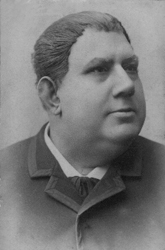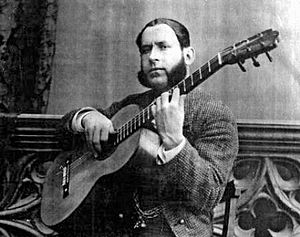Silverio Franconetti facts for kids
Silverio Franconetti y Aguilar (born June 10, 1831 – died May 30, 1889) was a very important flamenco singer. He was a key person during the "Golden Age" of flamenco. This was a time when many new flamenco song styles, called palos, were created. Flamenco artists also started to become professionals. The music moved from private parties to public places called cafés cantante. People said Silverio's voice was like "the honey from Alcarria," meaning it was very sweet and beautiful.
Contents
Silverio's Early Life
Silverio Franconetti was born in Seville, Spain. His father, Nicolás Franconetti, was from Rome, and his mother, María de la Concepción Aguilar, was from Alcalá de Guadaira. Silverio grew up in Morón de la Frontera. He learned to be a tailor.
When he was young, he spent time with Gypsies who worked in metal shops. He listened to their songs and learned a lot. A singer named El Fillo especially influenced him.
Becoming a Flamenco Star
Silverio soon decided to stop being a tailor. He wanted to be a singer. He started performing in Seville and then in Madrid. When he was 25, he moved to Montevideo, Uruguay. There, he worked as a soldier or a picador (a person who fights bulls on horseback).
In 1864, he returned to Spain to sing again. He teamed up with another singer, Manuel "El Burrero." They opened a café cantante together, which was also called El Burrero. However, they soon disagreed. El Burrero cared more about making money, but Silverio cared most about the quality of the music.
The "Café de Silverio"
Silverio soon opened his own café cantante, called the "Café de Silverio." He invited the best flamenco artists of his time to perform there. He also sang regularly himself. His café helped make cafés cantante very popular. In just a few years, many of these music halls opened across Andalusia and the rest of Spain.
His Singing Style
As a singer, Silverio learned most of his songs from El Fillo. But he changed these songs to fit his own unique style. It is hard to say for sure which flamenco songs he created himself. For example, the song known as cabal de Silverio is thought to be his version of a cabal song by El Fillo. Even with these discussions, Silverio was the most famous and talked-about singer of his time.
Silverio helped make flamenco popular by performing it in cafés cantante. At first, a folklorist named Demófilo did not like this. Demófilo wrote the first book about Silverio's life, called Colección de cantes flamencos.
See also
 In Spanish: Silverio Franconetti para niños
In Spanish: Silverio Franconetti para niños



